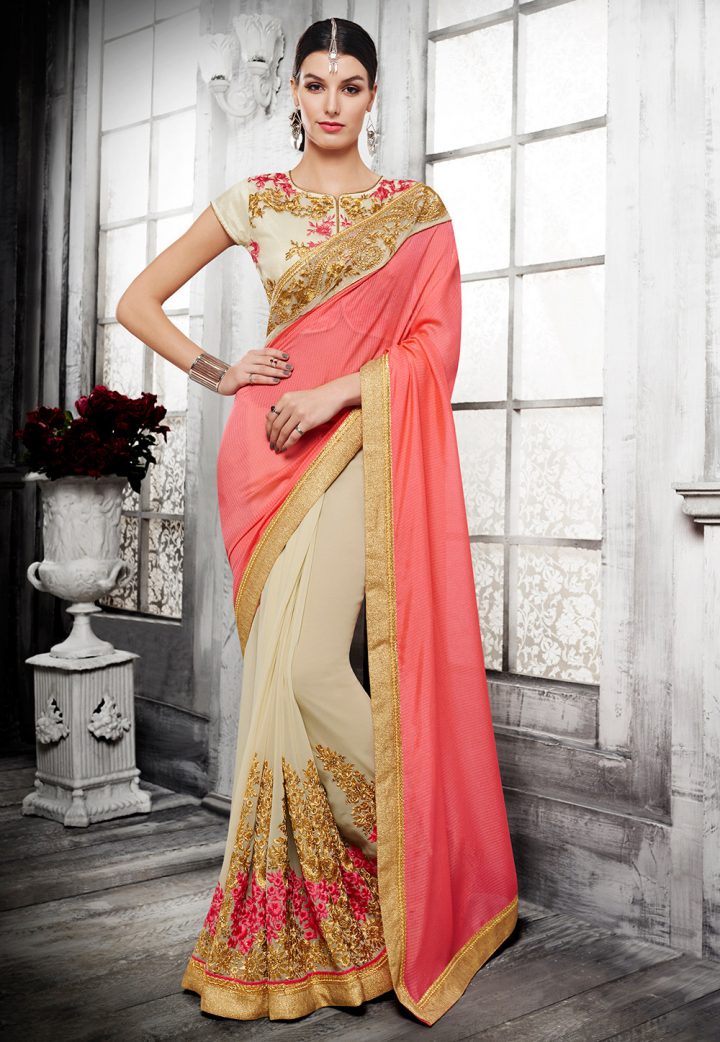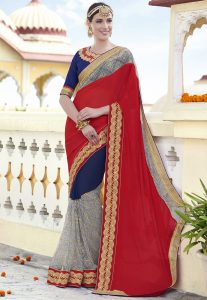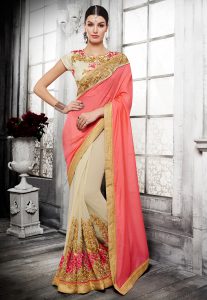
Half Half Sarees
A half half saree is an innovation that has been made to the original saree, which is a rectangular fabric at least 5 meters in length. The half half saree is so named because of the contrasting color of one half of the saree with the other half. While the elements of draping this saree remain the same, the color schemes are dual in nature and are meant to contrast each other. These types of sarees are very popular as Indian party wear and a number of women can be seen wearing them on occasions such as weddings, graduations and anniversary parties.
Background and Sources of Inspiration
The half half saree was inspired by the need to innovate with the most traditional of all Indian garments i.e. the saree. While this item of clothing is common and popular among married as well as older women, the half half saree appeals to a younger demographic.
This is considered to be one of the main driving factors of this style innovation. While the half and half saree concept can be applied onto a number of fabrics, cotton and silk are not preferred as they are sturdier and less malleable looms. Moreover, these fabrics tend to appeal less to the younger demographic whose aim of wearing a saree is to party in style.
However, initial innovations with the saree were in respect to the draping and styling of the garment itself. For instance, the ready-made saree or the half saree were a part of style innovations within the process of draping the saree. Further, traditional embroideries, looms, motifs, patterns and yarns may have been in colors that are different to the base of the saree, the concept of a dual color-scheme that contrast each other is relatively new.
The Making of Half Half Sarees
The saree is divided into two parts: the pleats (that is the body of the saree) and the pallu (that is the drape over the shoulder).
- The Pleats: The pleats and the body of the saree that is wrapped around the waist and drops to the floor are dyed in one color.
- The Pallu: The pallu, that is the piece of the saree that goes around the hips and onto the shoulder, is painted in a completely different hue from the pleats.
The two colors that are chosen for the dyeing of this saree are bold and are purposely made to contrast each other. However, the colors of the saree itself do not affect that nature of the embroidery that can be done on this garment. Neither do they affect the fabric that is used.
Style and Variety
Bold color combinations such as pink and green, purple and yellow, red and black, cyan and black, royal blue and rani pink (literally translated means ‘queen pink’ implying the royalty of the shade of pink) are popular choices amongst buyers.
Half half sarees in net, faux georgette, crepe, viscose, art silk, faux chiffon, brasso and even velvet are sought out by Indian buyers. The boldness of the colors is complemented by the softness of the drape of the saree that can be achieved by the use of these materials. The nature of the embellishments on the saree is determined by the type of occasion they are meant for. In this case, the boldness of the colors and the fabric used implies festivity, making the embroidery stand out.
Jacquard, zari work, patch border work, zardozi, resham embroidery, stone work and sequin work, appliqué are a few of the many embellishments that may go on a half half saree. These embellishments are largely dependent on the vision of the designer for the piece.
(Also Read: Nivi Style Saree Draping)
Present Day Scenario and Global Influence
The half half saree is steadily gaining prominence as the ultimate word in ethnic Indian party wear. The fusion of a traditional Indian garment with contemporary color schemes that are often seen on international runways is seen as evidence of progressive ethnic fashion in India.This innovation in the saree has been taken to international platforms by not just designers but also Indian style icons such as Deepika Padukone, Shilpa Shetty, Priyanka Chopra and Sophie Choudry.
Innovations
Within this ethnic innovation, another has been added by many designers. Many half half sarees have borders that may be in a different color and pattern altogether. It is not necessary that the border contrast the pleats and the pallu. In fact, a color that is mutually complementary is chosen for the border.
Wearing the Half Half Saree
The blouses that can be worn with this type of saree are diverse and based on the personal taste of the wearer. Anything from high collar and full sleeved blouses to backless or halter blouses go very well with this type of saree.
Maintenance
Half half sarees need to be maintained just as any other saree, depending upon its fabric and amount of work done on it. Particularly, its maintenance does not depend upon the colors of the fabric. Sarees with heavy work should preferably be dry cleaned whereas the subtle and simple variety can be washed in cold water using delicate suds.
(Also Read: Organza Fabric)
Facts and Trivia
- The Half Half Saree is different from the Half Saree (also known as Langavoni) which is worn by young girls in Southern India when they reach puberty.
- Half and half saree is a term also used for silk saree looms that have gold zari woven into the fabric, such as in Kanjeevaram sarees. However, this term has fallen out of use for the type.
References
Categories: Bollywood & Beyond, Ethnic Innovations, Outfits


